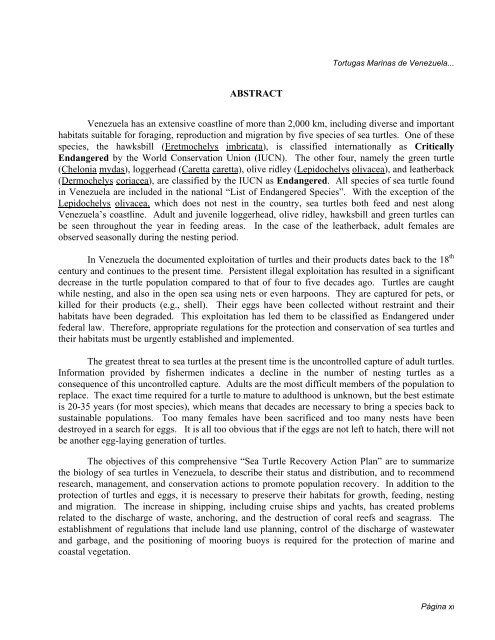You also want an ePaper? Increase the reach of your titles
YUMPU automatically turns print PDFs into web optimized ePapers that Google loves.
Tortugas Marinas de Venezuela...ABSTRACTVenezuela has an extensive coastline of more than 2,000 km, including diverse and importanthabitats suitable for foraging, reproduction and migration by five species of sea turtles. One of thesespecies, the hawksbill (Eretmochelys imbricata), is classified internationally as CriticallyEndangered by the World Conservation Union (IUCN). The other four, namely the green turtle(Chelonia mydas), loggerhead (Caretta caretta), olive ridley (Lepidochelys olivacea), and leatherback(Dermochelys coriacea), are classified by the IUCN as Endangered. All species of sea turtle foundin Venezuela are included in the national “List of Endangered Species”. With the exception of theLepidochelys olivacea, which does not nest in the country, sea turtles both feed and nest alongVenezuela’s coastline. Adult and juvenile loggerhead, olive ridley, hawksbill and green turtles canbe seen throughout the year in feeding areas. In the case of the leatherback, adult females areobserved seasonally during the nesting period.In Venezuela the documented exploitation of turtles and their products dates back to the 18 thcentury and continues to the present time. Persistent illegal exploitation has resulted in a significantdecrease in the turtle population compared to that of four to five decades ago. Turtles are caughtwhile nesting, and also in the open sea using nets or even harpoons. They are captured for pets, orkilled for their products (e.g., shell). Their eggs have been collected without restraint and theirhabitats have been degraded. This exploitation has led them to be classified as Endangered underfederal law. Therefore, appropriate regulations for the protection and conservation of sea turtles andtheir habitats must be urgently established and implemented.The greatest threat to sea turtles at the present time is the uncontrolled capture of adult turtles.Information provided by fishermen indicates a decline in the number of nesting turtles as aconsequence of this uncontrolled capture. Adults are the most difficult members of the population toreplace. The exact time required for a turtle to mature to adulthood is unknown, but the best estimateis 20-35 years (for most species), which means that decades are necessary to bring a species back tosustainable populations. Too many females have been sacrificed and too many nests have beendestroyed in a search for eggs. It is all too obvious that if the eggs are not left to hatch, there will notbe another egg-laying generation of turtles.The objectives of this comprehensive “Sea Turtle Recovery Action Plan” are to summarizethe biology of sea turtles in Venezuela, to describe their status and distribution, and to recommendresearch, management, and conservation actions to promote population recovery. In addition to theprotection of turtles and eggs, it is necessary to preserve their habitats for growth, feeding, nestingand migration. The increase in shipping, including cruise ships and yachts, has created problemsrelated to the discharge of waste, anchoring, and the destruction of coral reefs and seagrass. Theestablishment of regulations that include land use planning, control of the discharge of wastewaterand garbage, and the positioning of mooring buoys is required for the protection of marine andcoastal vegetation.Página xi
















